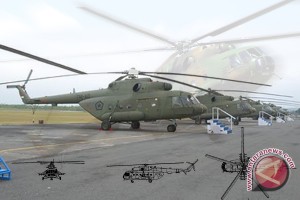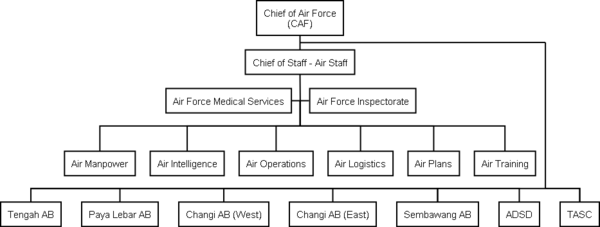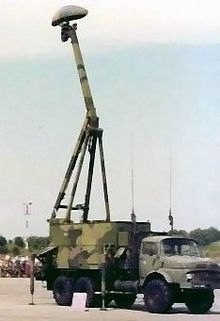From Wikipedia, the free encyclopedia
| Republic of Singapore Air Force |

RSAF Service Flag |
| Founded | 1 April 1973 |
| Country |  |
| Branch | Air force |
| Role | Air supremacy / defence |
| Size | 13,500 personnel
422 aircraft |
| Part of | Singapore Armed Forces |
| Engagements | Operation Iraqi Freedom,
Operation Enduring Freedom (as part of NATO-led ISAF) |
| Commanders |
| Chief of Air Force | Major General Ng Chee Meng |
| Insignia |
| RSAF crest |  |
| RSAF roundel - 3rd Generation (1990–present) |  |
| RSAF low visibility roundel |  |
| Aircraft flown |
| Attack | F-15SG, AH-64D |
| Fighter | F-16C/D |
| Interceptor | F-5S/T |
| Patrol | E-2C, G550 AEW&C, Fokker 50 ME2 |
| Reconnaissance | RF-5S |
| Trainer | S211, PC-21, TA-4SU, EC120 |
| Transport | KC-130B & C-130H, Fokker 50 UTL, KC-135R, CH-47SD, Super Puma |
The Republic of Singapore Air Force (RSAF,
Chinese:
新加坡空军部队;
Malay:
Angkatan Udara Republik Singapura;
Tamil:
சிங்கப்பூர் ஆகாயப்படை) is the
air arm of the
Singapore Armed Forces. It was first established in 1968 as the Singapore Air Defence Command (SADC). In 1975, it was renamed as the Republic of Singapore Air Force.
[1]
Mission statement
The following excerpts was taken from the official website of the Republic of Singapore Air Force
[2]: -
| “ | The RSAF is a First Class Air Force, always ready to deter aggression and defend Singapore and its interests. We will respond decisively to the full spectrum of missions from peace to war as part of an integrated SAF. We will be superior in the air and decisively influence the ground and maritime battles. The RSAF is founded on the core values of competencies of its World Class People. We Are committed to the nation, the SAF, the RSAF and to one another. Together, we will overcome adversity with courage and fortitude. Above all, our people are the heart of our organisation. | ” |
History
In January 1968, the British announced the imminent withdrawal of all their troops east of Suez by the end of 1971. Prior to then, Singapore had depended completely on Britain's
Royal Air Force (RAF) for its air defence, while the newly established
Singapore Armed Forces (SAF) had concentrated its efforts mainly on building up the
Singapore Army.
The predecessor to the RSAF, the SADC, was formed in September 1968. The SADC’s immediate task was to set up the Flying Training School to train pilots. Qualified flying instructors were obtained through
Airwork Services Limited, a UK-based company specializing in defence services. Basic training for pilots was carried out using two Cessna light aircraft hired from the Singapore Flying Club. The SADC also enlisted the help of the Royal Air Force which introduced the first flying training syllabus and provided two ex-RAF pilots as instructors, as well as facilities and services at
Seletar Airport. Finally, the first batch of six pilot trainees were sent to the
United Kingdom in August 1968 to undergo training in various technical disciplines. The training was based on the
Hawker Hunter, the SADC’s first air defence fighter. The following month, another pioneer group of technicians, this time from the rotary wing, were sent to France to begin their technical training on the
Aérospatiale Alouette III helicopter. In 1969, a number of local RAF technicians were released to join the fledging SADC. These
local technicians (local other ranks) had experience working on fixed-wing RAF aircraft such as the Hawker Hunter,
Gloster Javelin,
English Electric Canberra,
English Electric Lightning and
Avro Shackleton;
[3] as well as rotary-wing RAF aircraft such as the
Bristol Belvedere,
Westland Wessex and
Westland Whirlwind.
[3] It was also noted that the Israeli Defence Force Team assisted with the creation of the SADC.
[citation needed]
1973-1990: 2nd generation
ying-yang styled roundel
Comparison of older RSAF roundels Eight Cessna 172-K aircraft – the SADC’s first – arrived in May 1969 to be used for basic pilot training.
[4] By December, the first batch of students completed the course. Of these, six were sent to the UK to receive further training. On their return to Singapore in 1970, they were ready to operate the then newly-acquired Hawker Hunter fighter aircraft.
The pace of training pilots and ground crew picked up gradually. On 1 August 1969, Minister for the Interior and Defence,
Lim Kim San, inaugurated the Flying Training School (FTS) at
Tengah Air Base (then known as RAF Tengah). The inauguration of FTS brought SADC closer to its goal of fulfilling the heavy responsibility of defending Singapore's airspace.
The subsequent arrival of the
BAC Strikemasters in 1969, used for advanced phase flying training, meant that pilot trainees were now able to earn their initial wings locally rather than overseas. The first batch of locally trained fighter pilots were trained at the FTS and graduated in November 1970. Amongst this batch was 2LT Goh Yong Siang, who later rose to the appointment of Chief of Air Force on 1 July 1995. Gradually, the SADC had its own pilots, flying instructors, air traffic controllers, and ground crew.
When Britain brought forward its plan to withdraw its forces by September 1971, the SADC was suddenly entrusted with a huge responsibility and resources. Britain’s former air bases –
Tengah,
Seletar,
Sembawang and
Changi – were handed over to the SADC, as well as its air defence radar station and
Bloodhound II surface-to-air missiles.
In 1973, the SADC procured
Shorts Skyvan search-and-locate aircraft and
Douglas A-4 Skyhawk fighter-bombers. With a reliable mix of fighters, fighter-bombers, helicopters and transport aircraft, the SADC was ready to assume the functions of a full-fledged air force. On 1 April 1975, the SADC was renamed the Republic of Singapore Air Force (RSAF).
[1]
One of its first commanders was LTC
Ee Tean Chye.
[5][6]
[edit] Organisation
The RSAF is led by the Chief of the Air Force (CAF). The current CAF is
Major General Ng Chee Meng.
[7] The CAF reports directly to the Chief of Defence Force and is assisted by the Chief of Staff (Air Staff), BG Wong Huat Sern.
[8] The Chief Warrant Officer of Air Force is ME5 Andrew Koh.
[9] The Air Staff comprises six functional departments: Air Manpower, Air Intelligence, Air Operations, Air Logistics, Air Plans and Air Training. There are also two specialist departments: the Air Force Inspectorate (AFI) and the Office of the Chief Air Force Medical Officer (CAMO).
[8]
The organisation chart below shows the administrative chain of command with seven
formations:
Tengah Air Base,
Paya Lebar Air Base,
Changi Air Base (West),
Changi Air Base (East),
Sembawang Air Base, Air Defence Systems Division (ADSD) and the Tactical Air Support Command (TASC).
[10]
In 5 January 2007, Defence minister
Teo Chee Hean announced that the Air Force organisation chart will be re-structured into five major commands, namely the Air Defence Operations Command (ADOC), the Air Combat Command (ACC), the Participation Command (PC), the Air Power Generation Command (APGC) and the Unmanned Aerial Vehicle (UAV) Command (UC). The first to be inaugurated was ADOC, along the restructuring announcement.
Air Defence And Operations Command
Air Power Generation Command
The five major commands of RSAF ADOC is the principal agency in charge of planning and executing peacetime operations and air defence. ADOC is also responsible for the development and operational readiness of the command and control and ground-based air defence units of the RSAF. ADOC has 4 groups are its command. There are Operations Planning and Development Group (OPDG), formerly under Air Operations Department, Air Force Operations Group (AFOG), National Air Defence Group (ADG), Divisional Air Defence Group (DAG).
UAV Command was the second command to be inaugurated and become operational in May 2007.
[11] The main structures under UC are Operations & System Development Group (OSDG), headed by the Deputy Commander of UC and Squadrons and UAV Training School (UTS).
The next command to be inaugurated was PC in January 2008. Participation Command comprises the Operations Development Group (ODG), the Helicopter Group (HeliG), the Tactical Air Support Group (TASG), and the Divisional Air Defence Group (DAG).
[12]
The last two commands, ACC and APGC, were inaugurated together in August 2008 in conjunction with the RSAF 40th Anniversary. The ACC will bring together fighter and transport squadrons under one command, with central planning, control and execution of the air battle in operations. The APGC will enhance the missions of the ACC by ensuring that all air bases remain operational at all times, as well as improving the servicing and turn-around of aircraft to ensure continuous and responsive operations.
The ACC is responsible for the planning, control and execution of the air battle in operations. It brings together all fighter and transport squadrons that will carry out these tasks under a single command which will be responsible for training the pilots and aircrew to think and operate in a fully integrated way. The ACC consists of the Integrated System Development Group (ISDG), Operations Development Group (ODG), Integrated System Development Group (ISDG), Fighter Group (FG) and Transport Group (TG).
The APGC is set up to enable the RSAF to generate and sustain effective, timely and robust air power to meet the operational needs of the SAF. With the APGC, higher operational efficiency within each RSAF Air Base, and secondly, greater integration across the four bases are achieved. The APGC consists of the Operations Development Group (ODG) and four air bases: Changi Air Base, Paya Lebar Air Base, Sembawang Air Base and Tengah Air Base. The four support squadrons still remain organic to each Base but are under direct command of APGC. These four squadrons are: Airfield Maintainece Squadron (AMS), Ground Logistics Squadron (GLS), Field Defence Squadron (FDS) and Flying Support Squadron (FSS).
[edit] Overview
| Republic of Singapore Air Force |
|
The backbone of the RSAF is formed by the Block 52/52+
F-16 Fighting Falcons. These are armed with US-supplied
AIM-120C AMRAAM missiles and
LANTIRN targeting pods, laser guided munitions and
conformal fuel tanks for long-range strike.
While Singapore initially bought as many as 70 F-16 planes, on November 18, 2004, it was announced that the RSAF would donate its remaining 7 F-16A/B's to the
Royal Thai Air Force. It is believed that these early Block 15OCU aircraft were upgraded to "Falcon One" standard by
ST Aerospace before the transfer and delivered in late 2005. In return, the RSAF was permitted to train at the
Udon Royal Thai Air Force Base in north-east Thailand for a specified number of days each year. This would mean that the RSAF will operate only the Block 52/52+ model, as many as 62 F-16CJ/DJ planes.
Due to severe airspace constraints within Singapore, the RSAF operates its aircraft at several overseas locations in order to provide greater exposure to its pilots. With the F-16C/D Fighting Falcons,
KC-135R Stratotankers,
AH-64D Apaches and
CH-47SD Chinook helicopters based in the USA, the
Marchetti S-211s,
PC-21s, and
Super Puma helicopters in
Australia, and the
TA-4SU Super Skyhawks in France, almost one third of the force's inventory is based outside Singapore.
In 1994, the RSAF commenced a modernisation program for its fleet of approximately 49 operational (R)
F-5E and F-5F aircraft. The upgrade was performed by Singapore Technologies Aerospace (STAero) and the upgraded aircraft were designated (R)F-5S and F-5T respectively, operating from Paya Lebar Air Base. These upgraded F-5S/T, equipped with the Galileo Avionica's FIAR Grifo-F X-band Radar
[13][14][15] are thought to be capable of firing the AIM-120 AMRAAM missile but to date, no actual live-firing has actually been reported. For
in-flight refuelling, four KC-135Rs and four
KC-130Bs are commissioned to support the fighter force of F-16C/Ds and (R)F-5S/Ts.
Airborne Early Warning and Control (AEW&C) capability was introduced in 1987 when four
E-2C Hawkeyes were delivered to 111 Squadron. The duty of
Maritime Patrol and Coastal surveillance is performed by the five Fokker 50 MPA (entered service in 1991) of 121 Squadron, which can be armed with long-range anti-shipping
AGM-84 Harpoon missiles and ASW torpedoes.
As part of its fleet renewal process, the RSAF officially withdrew its fleet of
ST Aerospace A-4SU Super Skyhawk from front-line service on March 31, 2005 after 31 years of operations. The A-4SUs' achievements included flying directly from Singapore to the Philippines, incorporating the RSAF's first air-to-air refuelling mission in 1986, as well as the excellent aerobatic display of the 'red and white' Super Skyhawks flown by the
RSAF Black Knights during Asian Aerospace 1990.
[16] A month before its retirement, the Skyhawk squadron won top honours in a strike exercise against its more modern F-16 and F-5 counterparts.
Singapore ordered a total of twenty
AH-64D Apache Longbow attack helicopters in two batches. After a long period of negotiations over the delivery of the sophisticated Longbow
Fire-control radar, the first batch of eight aircraft, fitted with the Fire Control Radar, was delivered on 17 May 2002.
[17] The second batch of 12 Apaches were ordered in 2001 even before the first delivery took place.
[18] All of the initial eight Apaches are based in the
USA. Three of the Apache Longbows returned in January 2006 at the request of the Minister of Defence.
Apart from the six CH-47SDs delivered from 1996, a new batch of six aircraft was ordered in 1997, with an option of four extra airframes. At least 12 CH-47SD have been delivered and are in service at Sembawang Air Base. It is believed that these had been upgraded to the SD standard prior to delivery.
Eight CH-47SDs were also deployed to support the relief efforts in the aftermath of the
Indonesian Tsunami. It was the first and one of the few countries to reach the affected areas. The RSAF deployed dozens of C-130Hs, CH-47SDs and AS 332Ms there along with three of the RSN's latest Landing Ship Tanks (RSS Endurance, RSS Persistence and RSS Endeavour of the
Endurance class LST) as well as
Singapore Armed Forces vehicles, engineers, and medical teams.
In September 2005, the RSAF sent three CH-47SD Chinook helicopters, later augmented by a fourth CH-47SD Chinook, to provide assistance in the rescue and evacuation of stranded civilians after
Hurricane Katrina struck New Orleans and nearby areas in the United States.
[19] The
humanitarian effort by Singapore involved more aircraft than any other foreign countries.
[20]
Since 2003, the RSAF has also made deployments of KC-135 tankers and C-130 aircraft to the
Persian Gulf in support of the multinational efforts for the
reconstruction of Iraq. RSAF personnel have carried out airlift, transportation and supply, and air-to-air refueling missions in support of the multinational forces, assisting the
Coalition in carrying supplies and personnel, transporting humanitarian material and conducting medical evacuation operations.
[21][22]
Air Bases
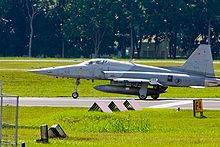
An F-5S of 144 Sqn preparing for take-off.

An F-16C of 140 Sqn scrambling.

Demonstration of a M-113A2 Ultra Mechanised Igla IFU on deployment, visible in the background is an
I-HAWK SAM launcher.
- Paya Lebar Air Base
- 122 Sqn 6 C-130H (Transport), 4 KC-130B (Transport/Aerial refuelling)
- 141 Sqn 6 F-5S (Interceptor), 1 F-5T (Training/Interceptor) - Disbanded since Nov 2005 with aircraft being reassigned to 144 and 149 Sqn.
- 144 Sqn 15 F-5S (Interceptor), 7 F-5T (Training/Interceptor)
- 149 Sqn 15 F-5S (Interceptor), 1 F-5T (Training/Interceptor); currently transitioning to the F-15SG (Strike), received 5 F-15SG to date.[23]
- Tengah Air Base
- 111 Sqn 4 E-2C Hawkeye (AEW & C); currently transitioning to G550 CAEWs
- 140 Sqn 7 F-16C (Interceptor), 5 F-16D Blk 52 (Strike)
- 142 Sqn 18 T/A-4SU Super Skyhawks (Fighter-bomber) - disbanded in 2004.
- 143 Sqn 2 F-16C (Interceptor), 10 F-16D Blk 52 (Strike)
- RSAF Black Knights - RSAF's aerobatic team.
- Chong Pang Camp SADA (Singapore Air Defense Artillery)
- 3rd DA RBS 70 SAM, IGLA SAM, Giraffe Radar
- 6th DA RBS 70 SAM, IGLA SAM, Giraffe Radar
- 9th DA RBS 70 SAM, IGLA SAM, Giraffe Radar
- 18th DA Mistral SAM
- 160 Sqn Oerlikon 35 mm AA Guns (Airfield defence)
- Lim Chu Kang Camp II SADA (Singapore Air Defense Artillery)
- 163 Sqn I-HAWK SAM (Medium altitude air defence)
- 165 Sqn Rapier Blindfire SAM (Low altitude air defence)
- Other assets of SADA (Singapore Air Defense Artillery)
- 201 Sqn FPS 117 Radar (Fighter control, SAM control, Surveillance, ASP)
- 203 Sqn LORADS Radar (RASP, SAR, "listening watch" for distress signals)
- Murai Camp
- 116 Sqn Hermes 450 (Reconnaissance)
- 128 Sqn 40 IAI Searcher (Reconnaissance)
Personnel
Military ranks in the Singapore Armed Forces are identical across the three services except for the flag ranks of the
RSN. They are based on the Army model. The official table of ranks stops at three stars for all three services.
[24] NATO rank codes are not officially used, but are listed here for easy comparison with other armed forces.
Like the
Navy, the majority of Air Force personnel are regulars. This is due to the specialized and technical nature of many jobs. The employment of
National Servicemen in various roles are limited mostly to the infantry-like Field Defence Squadrons which do not require such specialised training.
Overseas detachments (Training)
2004, TA-4SU (933) on the flightline of Cazaux Air Base
6 June 2010, a pair of A-4SU Super Skyhawks (serials 938 & 909) on static display during an
air show at the
Istres Air Base
Super Skyhawks in France - Redmond Taylor AHP - Grand Prairie AASF (Grand Prairie, Texas)
- 149th AVN, 6 × CH-47SD (Peace Prairie CH-47 Training)[27]
- Silverbell Army Heliport (USA)
- E/1-285th AVN, 8 × AH-64D (Peace Vanguard AH-64D Training)[32]
Future plans
The
F-15SG Strike Eagle is a variant of the F-15E Strike Eagle and is similar in configuration to the F-15K sold to
South Korea, but differs in the addition of the
APG-63(V)3 active electronically scanned array (AESA) radar developed by
Raytheon. The F-15SG will be powered by two
General Electric F110-GE-129 29,400 lbf (131 kN) thrust engines.
In February 2003, Singapore joined the
JSF program's System Design and Development (SDD) Phase, as a Security Co-operation Participant (SCP).
[33][34] The first deliveries of the F-35 are not expected before 2015, but replacement for some of the
ST Aerospace A-4SU Super Skyhawks was needed by 2007. As a start, 20 F-16D Block 52+ have been delivered from 2003 under project Peace Carvin IV.
The RSAF embarked on its Next Generation Fighter (NGF) programme to replace the aging A-4SU Super Skyhawks. The original list of competitors was shortlisted to the final two -
Dassault Rafale and the
F-15SG Strike Eagle. The DSTA (Defense Science & Technology Agency) conducted detailed technical assessment, simulations and other tests to assess the final selection. On 6 September 2005, it was announced that the Boeing F-15SG Strike Eagle had won the contract over the Rafale.
[35]
The initial order is for 12 aircraft with 8 options. Eventually, as many as 40 to 60 aircraft may be procured in several batches. Pending news on
Lockheed Martin's
F-35 Lightning II's progress, more F-15SGs may be bought, with the upper limit, as disclosed by the RSAF, being 80 F-15SG aircraft in total. On 22 October 2007, Singapore's Ministry of Defence (MINDEF) exercised the option to purchase eight more F-15SG fighters as part of the original contract signed in 2005. Along with this buy, an additional order for four F-15SGs was made, bringing the total number of F-15SGs purchased to 24.
In January 2005, it was announced that 6
Sikorsky S-70B (derivative of
SH-60 Seahawk) naval helicopters will be purchased, complete with anti-surface and anti-submarine weapons and sensors.
[36] These will be operated by RSAF pilots, with System Specialists of the
Republic of Singapore Navy operating the sensors and weaponry. They will operate from the Navy's new
Formidable class frigates, and when operating from land will be based at Sembawang Air Base. All 20 AH-64D Longbow attack helicopters have been delivered, achieving pilot IOC. 12 of these Longbow Apaches were deployed back to Singapore and took part in combined arms exercises with the Army.
In April 2007, it was announced that the 4 E-2C Hawkeyes were to be replaced with 4 Gulfstream G550s which would become the primary airborne early warning aircraft for the RSAF.
[37][38] Not included in the deal is an additional G550 as an AEW trainer, which will be acquired and maintained by ST Aerospace on behalf of RSAF.
[39]
In July 2010, the
Alenia Aermacchi M-346 Master was selected by the RSAF to replace the A-4SU Super Skyhawks in the Advanced Jet Training (AJT) role, currently based at
BA 120 Cazaux Air Base in France.
[40][41] And in a press release by the
Singaporean Ministry of Defence on 28 September 2008,
ST Aerospace had been awarded the contract to acquire twelve M-346 and a ground based training system on behalf of RSAF. As stipulated in the contract, ST Aerospace will act as the main contractor to maintain the aircraft after delivery by Alenia Aermacchi while
Boeing would supply the training system. Delivery date is scheduled from 2012 onwards.
[42][43][44]
The backbone of the transport fleet are the four KC-130B, one KC-130H and five C-130H Hercules transport aircraft, which are expected to remain in service through 2030, will be undergoing an extensive modernisation process to bring all ten existing airframe to the same common standard. The first airframe, a KC-130B, was returned to frontline service on 21 September 2010. ST Aerospace, the main contractor behind the project, is expected to upgrade the other nine airframes for the RSAF within the next seven years. Included in the package is the replacement of cockpit
flight management system with a modern
glass cockpit avionics suite, central engine displays to replace analogue gauges, improved voice communications, digital autopilot, flight director as well as a digital weather radar, which will make the aircraft
Global Air Traffic Management-compliant. Also, the C-130Bs will receive an
auxiliary power unit and
environmental control system in common with the C-130Hs. Once the upgrade is completed, this will effectively give the RSAF five refueller KC-130Hs and five Cargo C-130Hs.
[45][46]
In December 2010, the RSAF issued a letter of request to inspect stored ex-US Navy
P-3C Orion aircraft that have been retired from active duty. Lockheed Martin believes the RSAF has a requirement of 4 to 5 of these aircraft, which would be modernized extensively before reintroduction into active service.
[47]
[edit] Weaponry

A fully bombed-up F-16D+ of 145 Sqn on static display during RSAF Open House 2008.

Rear view of the same aircraft.
[edit] Aircraft
[edit] Current
[edit] Historic
[edit] Fixed-wing aircraft
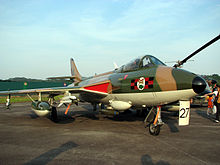
A retired
140 Sqn Hawker Hunter FGA.74S - serial number 527 (ex-RAF XF458), parked outside the RSAF Museum. Note also the number of hardpoints and the ADEN gun ports which had been
faired over to protect this museum piece against the weather.
 Hawker Hunter — 12× FGA.74, 26× FR.74A/B, and 8× T.75/A (excluding one T.75A which was lost in accident before delivery) were delivered to RSAF in 1970 and 1973. Upgraded in late 1970s by Lockheed Aircraft Services Singapore (LASS), the type was redesignated as FGA.74S, FR.74S and T.75S. Retired and phased out of service in 1992, only 4 were preserved as museum exhibits and gate guards while the remaining 21 airworthy airframes was sold to an Australian Warbird broker, Pacific Hunter Aviation Pty, in 1995.[57][58]
Hawker Hunter — 12× FGA.74, 26× FR.74A/B, and 8× T.75/A (excluding one T.75A which was lost in accident before delivery) were delivered to RSAF in 1970 and 1973. Upgraded in late 1970s by Lockheed Aircraft Services Singapore (LASS), the type was redesignated as FGA.74S, FR.74S and T.75S. Retired and phased out of service in 1992, only 4 were preserved as museum exhibits and gate guards while the remaining 21 airworthy airframes was sold to an Australian Warbird broker, Pacific Hunter Aviation Pty, in 1995.[57][58] General Dynamics F-16 Fighting Falcon — 4× F-16As and 4× F-16Bs delivered in 1988 under the Peace Carvin I program, one F-16A was lost following a mid-air collision with another F-16A over South China Sea in 1990. All surviving airframes were retired in 2002 and was subsequently upgraded locally to "Falcon One" standard by ST Aerospace before being transferred to Royal Thai Air Force in 2004.[48][54]
General Dynamics F-16 Fighting Falcon — 4× F-16As and 4× F-16Bs delivered in 1988 under the Peace Carvin I program, one F-16A was lost following a mid-air collision with another F-16A over South China Sea in 1990. All surviving airframes were retired in 2002 and was subsequently upgraded locally to "Falcon One" standard by ST Aerospace before being transferred to Royal Thai Air Force in 2004.[48][54] Short SC.7 Skyvan — 6× Skyvan 3Ms delivered in 1973 and retired in 1993.[48]
Short SC.7 Skyvan — 6× Skyvan 3Ms delivered in 1973 and retired in 1993.[48] BAC Jet Provost — 5× T.52s (ex-South Yemen Air Force airframe) operated from the 1975 until 1980.[48][59][60]
BAC Jet Provost — 5× T.52s (ex-South Yemen Air Force airframe) operated from the 1975 until 1980.[48][59][60] BAC Strikemaster — total 25 received (16× Mk.84s delivered in 1969 from UK plus 4× Mk.81s from South Yemen in 1975 and another 5× Mk.82s from Oman in 1977), all were retired in 1984 with one airframe preserved at the RSAF Museum while the remaining 13 airworthy airframes were sold to a Warbird broker.[48][61]
BAC Strikemaster — total 25 received (16× Mk.84s delivered in 1969 from UK plus 4× Mk.81s from South Yemen in 1975 and another 5× Mk.82s from Oman in 1977), all were retired in 1984 with one airframe preserved at the RSAF Museum while the remaining 13 airworthy airframes were sold to a Warbird broker.[48][61] Cessna 172 — 8× F172Ks delivered in 1969, retired in 1972.[48]
Cessna 172 — 8× F172Ks delivered in 1969, retired in 1972.[48] Lockheed T-33 Shooting Star — 20× T-33As (ex-French Air Force airframes), operated from 1980 until retired in 1985.[48]
Lockheed T-33 Shooting Star — 20× T-33As (ex-French Air Force airframes), operated from 1980 until retired in 1985.[48] SIAI-Marchetti SF.260 — 14× SF.260Ms delivered in 1971 plus 12× SF.260Ws delivered in 1979 and 1981. All remaining 19 airworthy airframes retired in 2002 and transferred to the Indonesian Air Force.[48][62]
SIAI-Marchetti SF.260 — 14× SF.260Ms delivered in 1971 plus 12× SF.260Ws delivered in 1979 and 1981. All remaining 19 airworthy airframes retired in 2002 and transferred to the Indonesian Air Force.[48][62] SIAI-Marchetti S.211 — Since 1984, 32× S.211s were acquired for RSAF's Basic Jet Training (BJT) program (this figure includes 24 airframes which were assembled locally by Singapore Aircraft Industries plus two former Haitian aircraft acquired as attrition replacements in 1994). Phased out from June 2008, of the remaining 25 airworthy S.211s, 21 were sold off to International Air Parts (IAP) Group Australia Pty Ltd in 2009 while 4 were shipped back to Singapore, being preserved as museum exhibits.[48][63]
SIAI-Marchetti S.211 — Since 1984, 32× S.211s were acquired for RSAF's Basic Jet Training (BJT) program (this figure includes 24 airframes which were assembled locally by Singapore Aircraft Industries plus two former Haitian aircraft acquired as attrition replacements in 1994). Phased out from June 2008, of the remaining 25 airworthy S.211s, 21 were sold off to International Air Parts (IAP) Group Australia Pty Ltd in 2009 while 4 were shipped back to Singapore, being preserved as museum exhibits.[48][63]
[edit] Rotary-wing aircraft

A retired
120 Sqn Alouette III (SA316B) on static display at the RSAF Museum.
Air-defence
Others
RSAF Black Knights
First formed in 1973 at Tengah Air Base, the
Black Knights is RSAF's official aerobatic team and has been performing on an ad-hoc basis since its inception with volunteer pilots drawn from various front line squadrons within the RSAF.
[16]
The RSAF maintains the Air Force Museum, which was first located at Changi Air Base before it was relocated to a purpose-built building currently situated along Airport Road adjacent to Paya Lebar Air Base. The museum is open to the public and showcases the air force's history and capabilities.
In popular culture
Fictional Television programs
See also
sumber :
WIKIPEDIA  Rusia
Rusia



